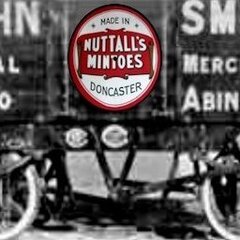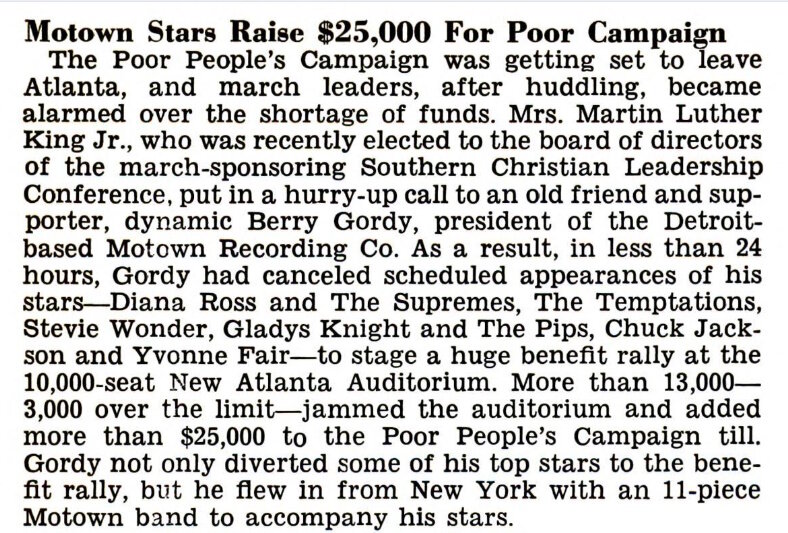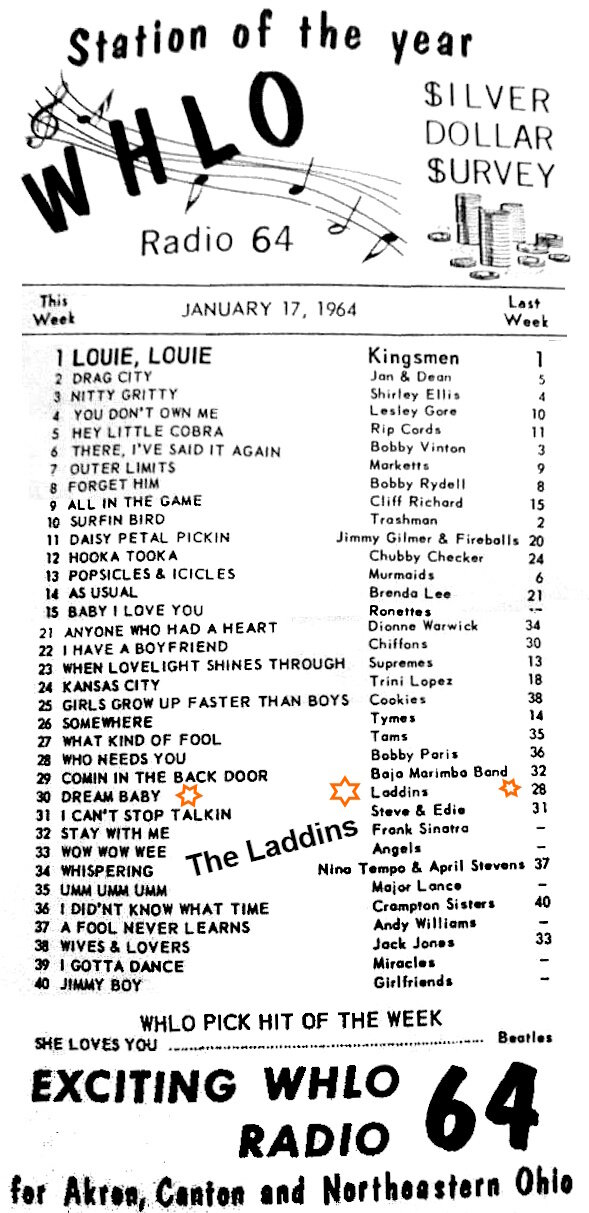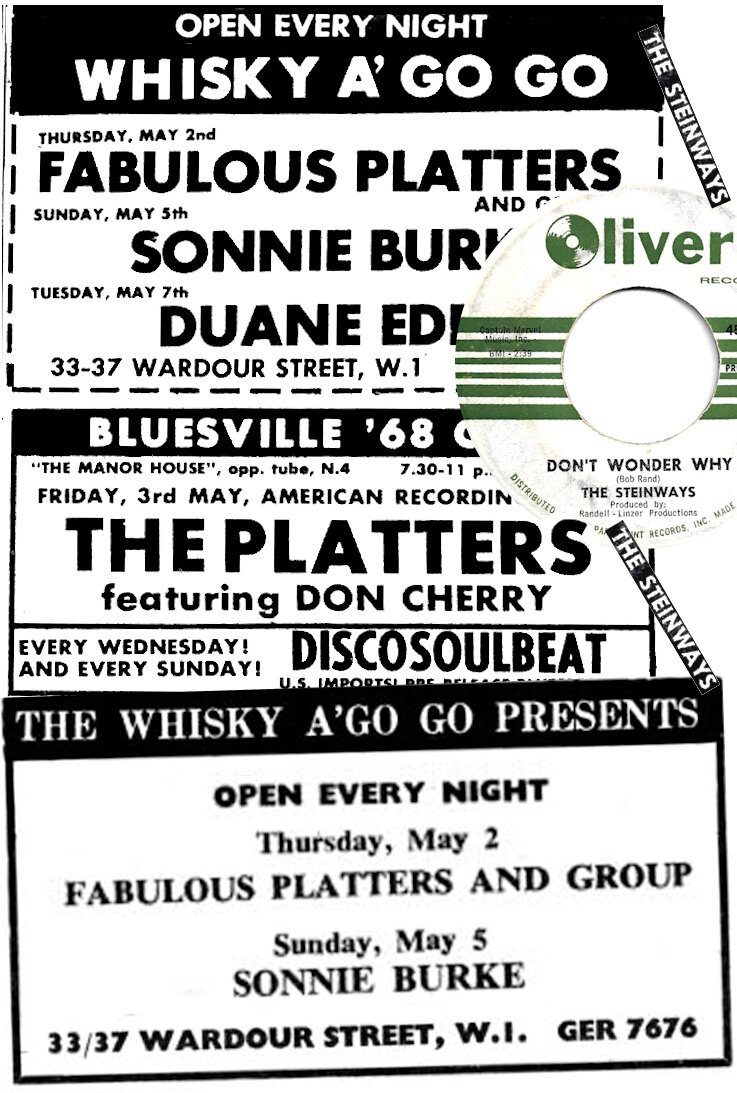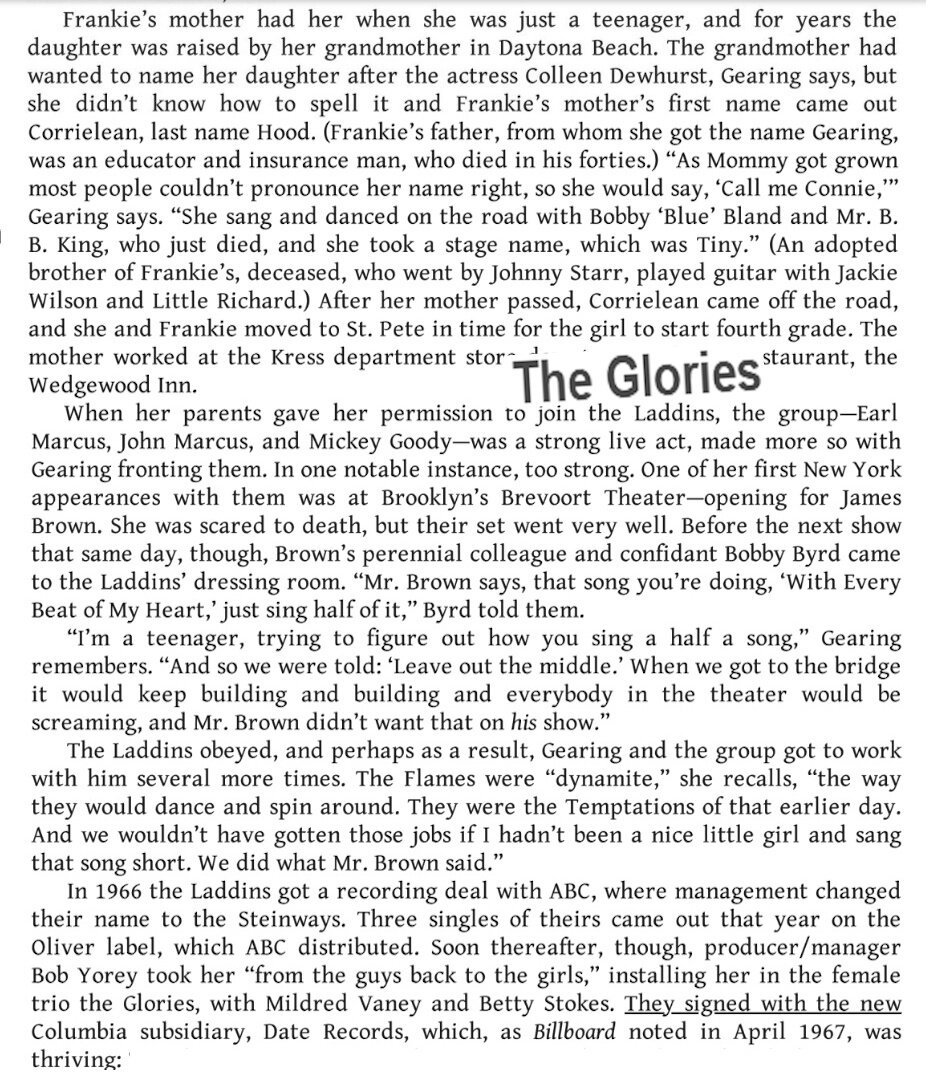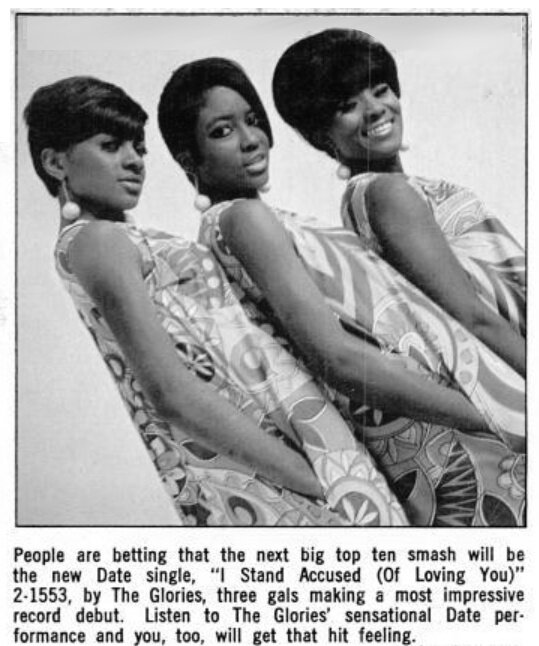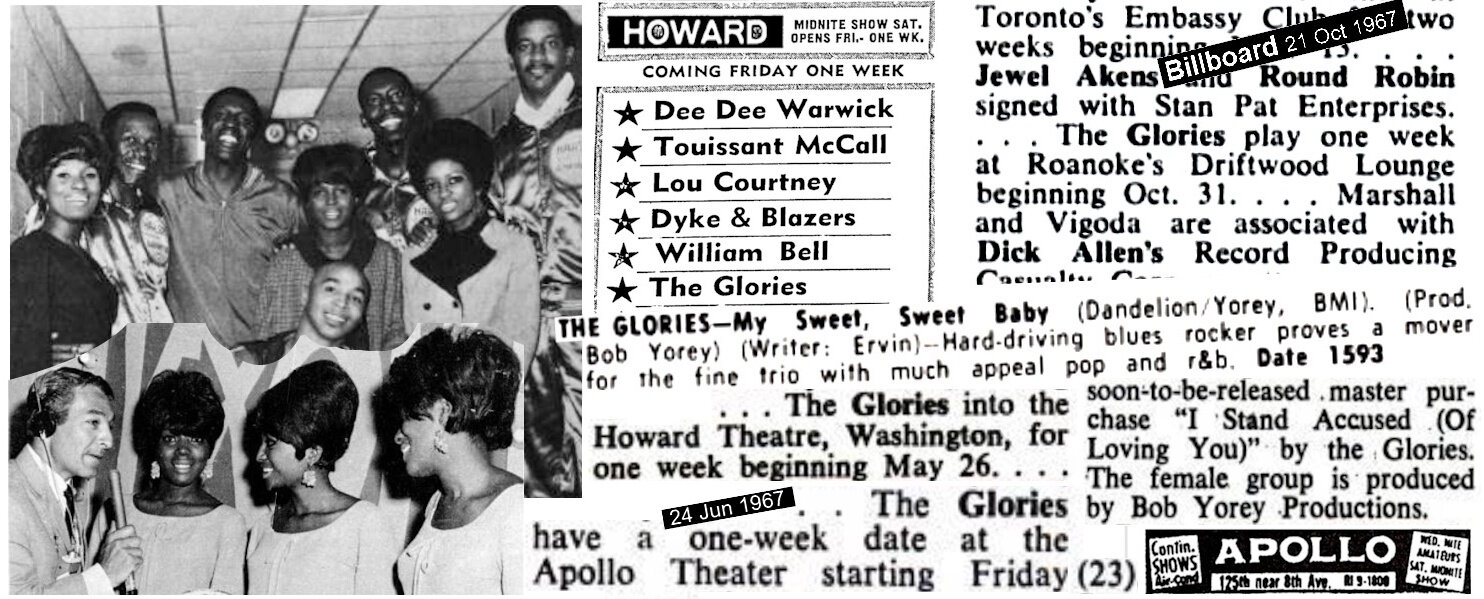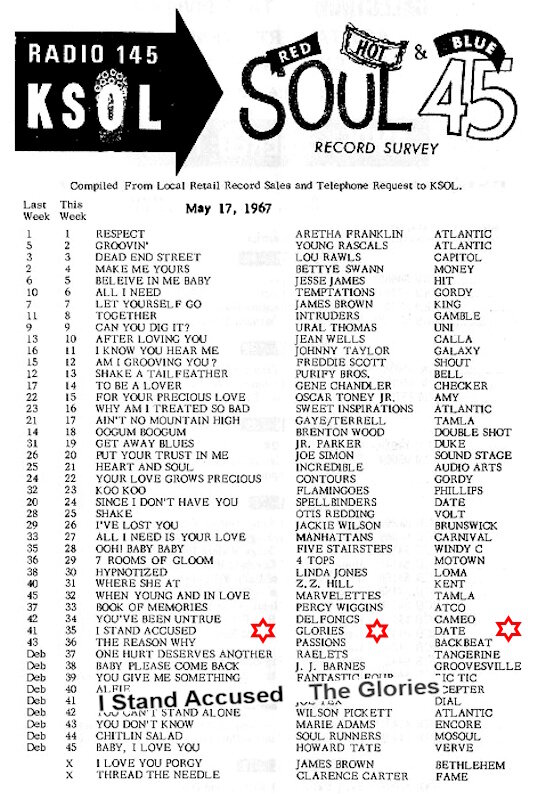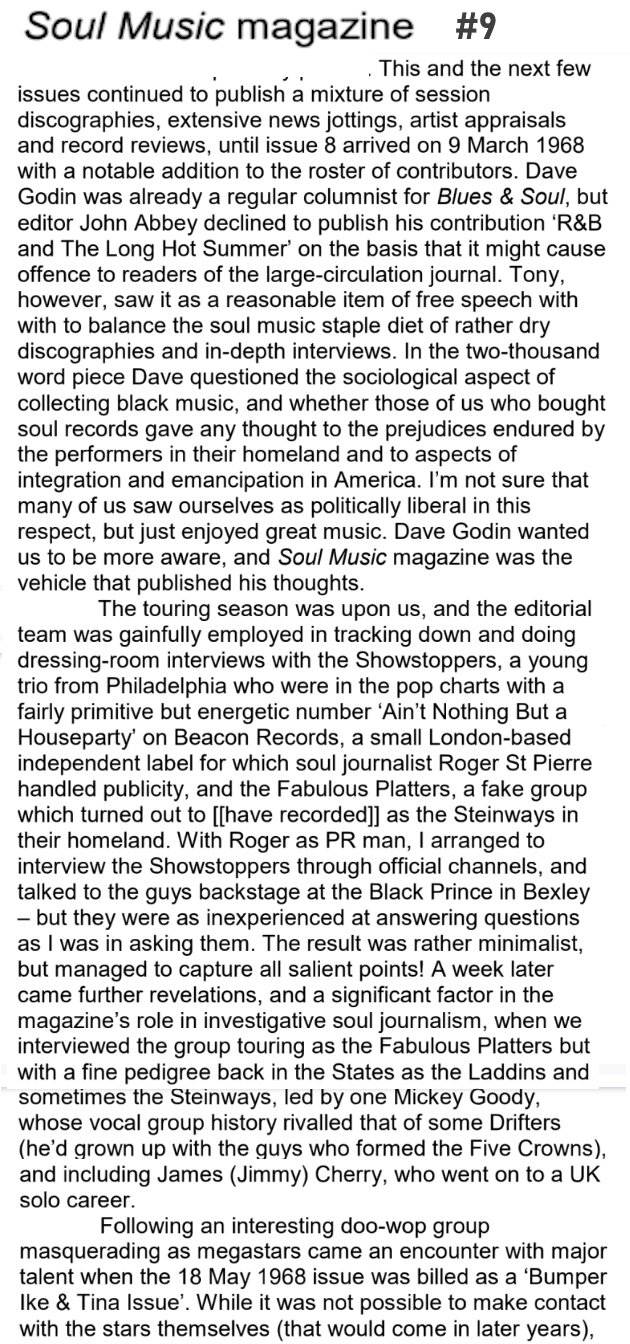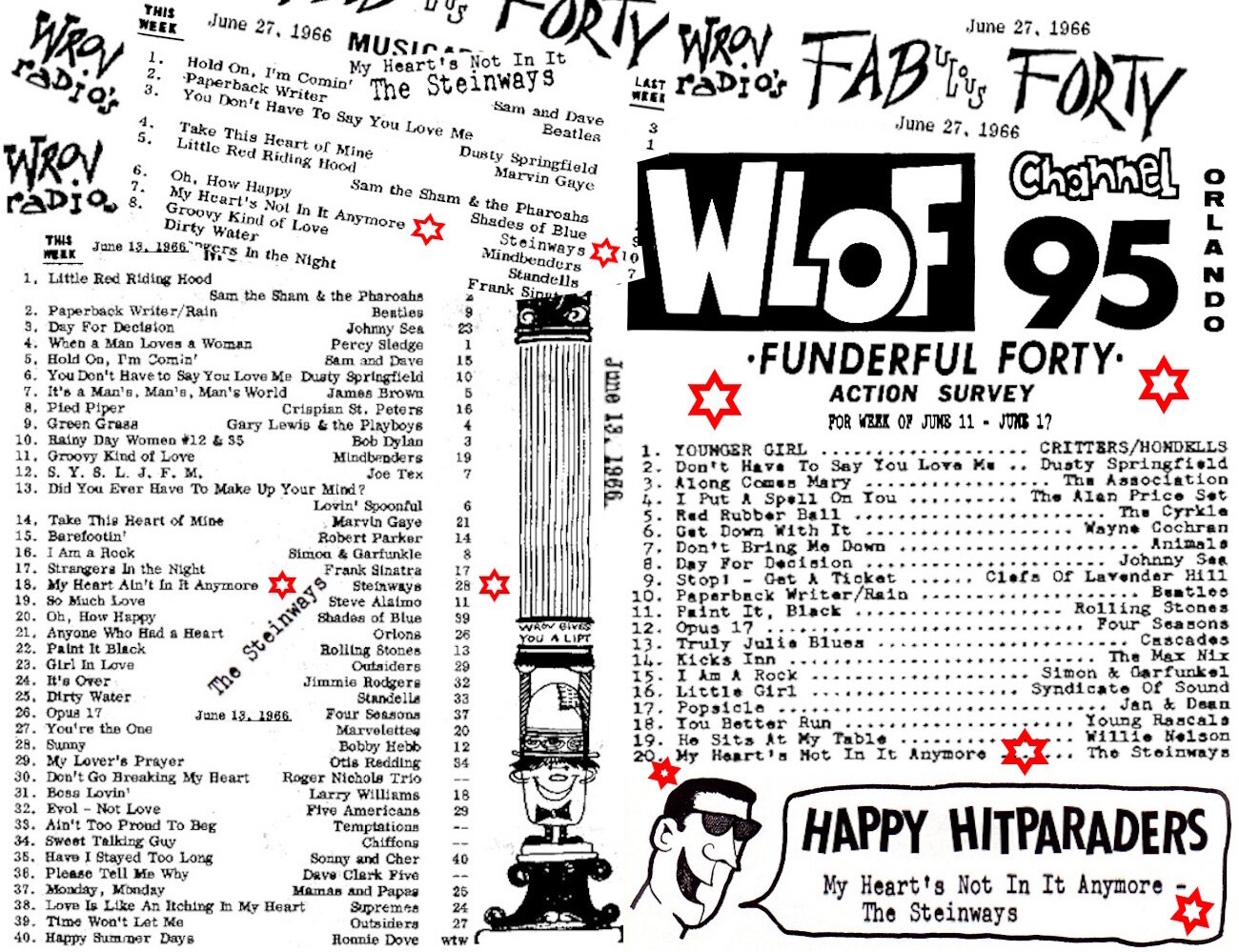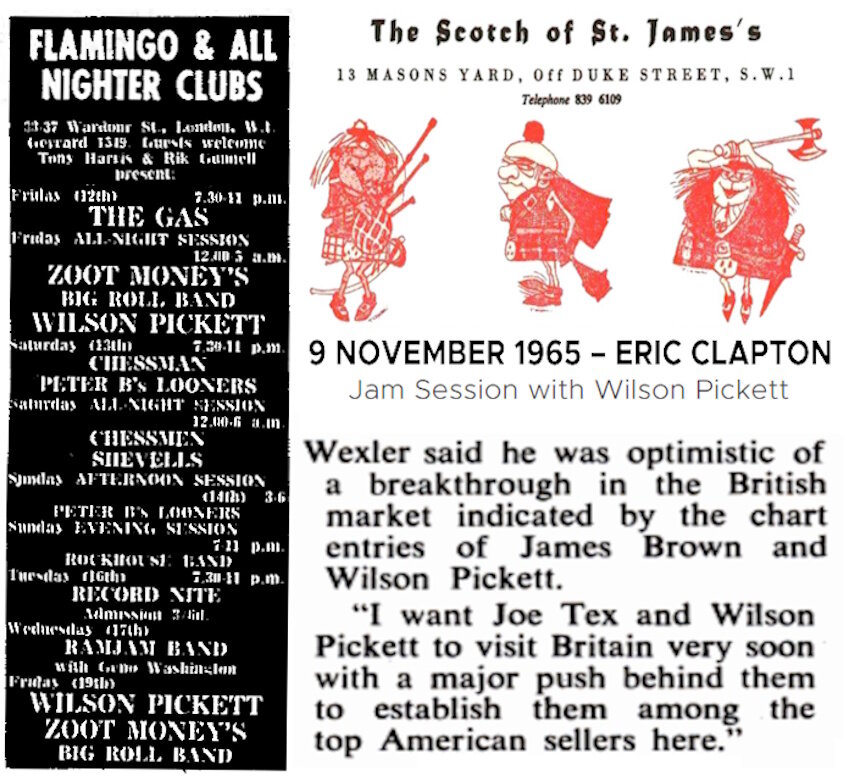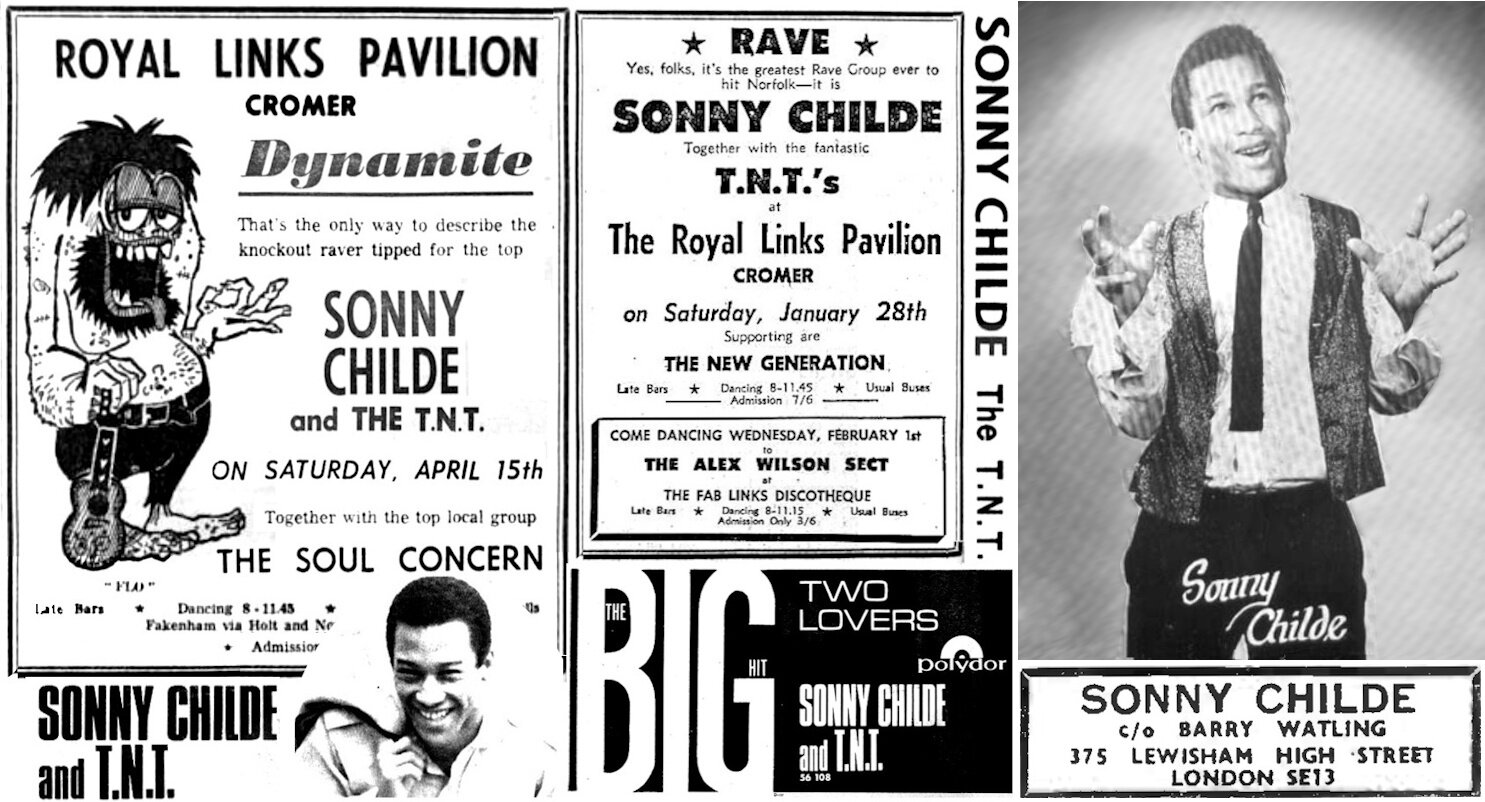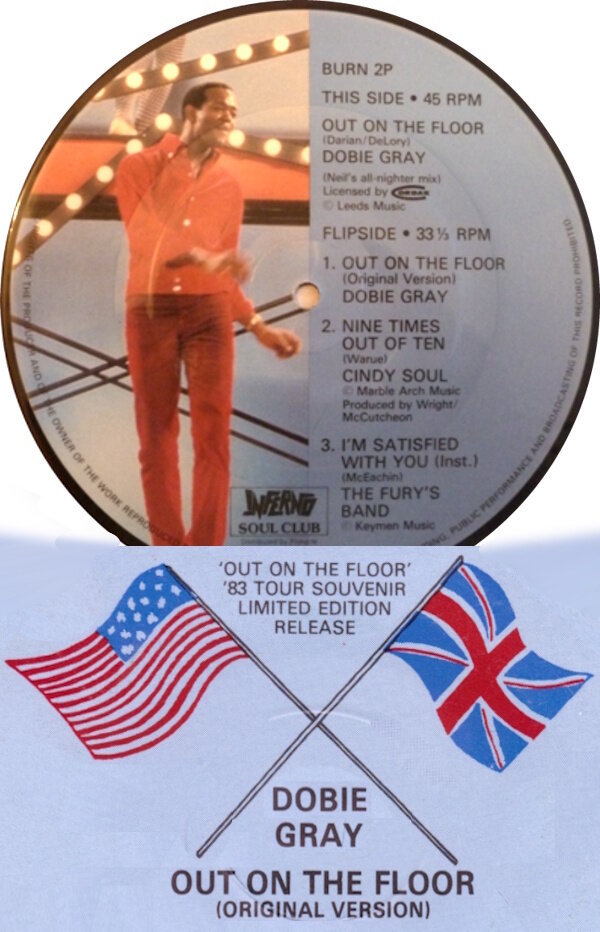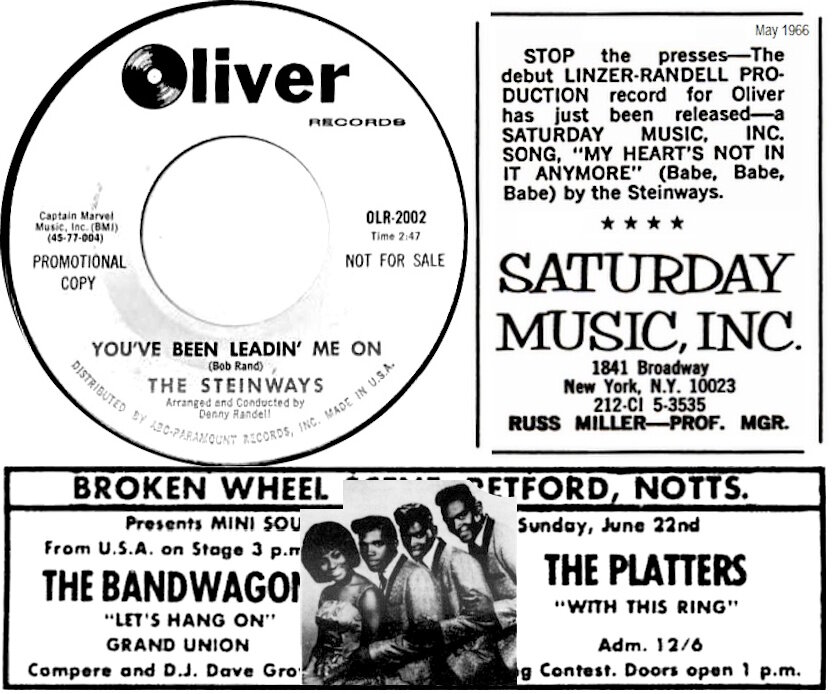-
1960's Dance Crazes
A dance for which the top 45 related release was super successful was BAREFOOTING Not sure what the dance actually consisted of, once you'd taken your shoes off, but I bet Robert Parker could have told you. His cut was so successful that even though it was made in New Orleans, (almost as far south in mainland UA as you could get - if you ignored Florida), it still enjoyed wide popularity north of the US border. On Canadian pop radio station CKLG, it even topped their chart ...
-
1960's Dance Crazes
The Slow Fizz, the Freeze & the Philly Freeze (those ones obviously had everyone stopping dead in their tracks when FREEZE was shouted out on the track).
-
Leslie Wilson R.I.P.
He replaced Jeffrey Osbourne as the group's lead singer (1981). He also co-wrote "Love Magic".
-
Grittiest Motown Girl Group Song
If it's OK I want to open up the discussion a bit. Berry Gordy always strived to reach the biggest of audiences, i.e. the white pop market in addition to black buyers. So he played his cards to try to ensure Motown's releases would get much wider radio airplay, reach a far wider audience & thus sell many more units (either 45's or LPs). Hence the Quality Control meetings, the refinement of each acts actions (getting in & out of cars in a dignified way, etc.), the great 'classy' outfits his acts wore, the professional stage moves drilled into each act by Cholly Atkins. He saw the goal of his top acts as being at home in the nations top supper clubs (the Cocacabana, etc). Everything was to be classy & polished to help sell more units. So, a gritty rough performer had to have their 'edges' smoothed off. I'm sure quite a few female (& male) Motown acts were capable of being raw & gritty but they were encouraged not to be. The companies in-house musicians would have had similar treatment -- class playing ruling over their more jazzy extremes. On the singing side, I'll use Yvonne Fair as my example. (SOME OF WHAT FOLLOWS I'M ASSUMING) ... Chuck Jackson signed with Motown in late 67 & had his 1st Motown release in Jan 68. He had toured & was friends with Yvonne. She'd been without a record deal since 66. Chuck & Yvonne were part of the team Motown selected to perform on a big charity gig in May 68. It seems Chuck (on getting with Motown) insisted that they sign Yvonne asap (by May 68 at the latest). She was soon doing shows with Motown acts -- a big one being in early September 69 @ the Apollo that starred Smokey & the Miracles with Yvonne, Bobby Taylor, the Fantastic Four (& the Emotions) also on the bill. She also stepped in to do some concerts with Marvin Gaye when Tammi Terrell was too ill. In the studio, Motown initially cut Yvonne on duet sessions with Chuck Jackson but none of those tracks were released. She was teamed with several producers at Motown but only one single was released "Stay A Little Longer" b/w "We Should Never Be Lonely My Love". The first studio session for these 45 tracks took place on 31 May 1968 but the 45 was released on SOUL (Motown's label for 'robust singers)' in July 1970 (a full 26 months later). The 45 seemed to receive no promotion at all. After that 45, Yvonne would go back into the studio on occasions but her next 45 didn't escape till May 74. Yvonne had a proven record both on vinyl & on live shows but Motown seemed unsure if they should release any of the tracks she had cut for them up to May 74 -- by which time she'd been signed with them for at least SIX YEARS. It seems that she was indeed TOO GRITTY for the company, at least until funky tracks had started to sell in large quantities by the mid 70's. I'd love to get Robb's input on this subject (... & in passing, was Edwin Starr too gritty for the company too ?).
-
Leslie Wilson R.I.P.
Posted on Facebook ... With great sadness The New Birth family mourns the passing of Leslie Wilson. The voice of New Birth passed quietly in his sleep last night. I loved Leslie's vocals, his voice was so distinctive. His work on New Birth's 'Behold The Mighty Army' LP was great. He quit the group not long after to front L.T.D. It was his lead vocal on the big Clifton Hall's MS anthem "Love Magic" (a Richard Sealing spin) ...
-
Grittiest Motown Girl Group Song
This lady was certainly capable of delivering real soul with a gritty edge ... pity more of her early Motown stuff didn't escape at the time ...
-
Grittiest Motown Girl Group Song
Can't really describe Mary Well's vocal style as gritty, it was a lot more smooth than that ... I've always liked this one though. It's a pity she left the company & the track was left in the vaults instead of escaping on 45 ...
-
The Fabulous Platters aka The Steinways
Many folk struggle to understand why a group would return to tour the UK again after they discovered they were being passed off as a different group (i.e they would be a FAKE GROUP) when doing shows here. It's not as simple as that though. Take the Laddins / Steinways for instance. They had started out in the mid 50's and had managed to record & get released a decent number of 45's. However their last single release had been "Dizzie Jone's Birdland" at the start of 1964. They'd added Frankie Gearing to the group line-up & this had revamped their sound. They plugged away & landed a prestigious booking (along with the Drifters & Little Willie John) @ the Harlem Apollo in March 1966. This must have caught the attention of a record company guy as they were signed up to the new Oliver label & a 45 was released in May 66 ("My Heart's Not In It Anymore"). this got some radio action and so a 2nd 45 followed that October. But apart from some decent gigs in Miami (where they were still popular as both the Laddins & as the Steinways, very little was happening for the group. Frankie Gearing jumped ship & helped form a femme trio, the Glories early in 1967. The group were signed to Columbia's Date label and had their first 45 out ("I Stand Accused) in early May 67. Reaction to the single was good, with strong radio airplay leading to entries on radio stn charts across in US. So the girls were added to a touring package that played the Howard Theatre in Washington DC that same month. Just 4 weeks later (June 23rd), they were on @ the Apollo in Harlem. More 45's followed and the Glories were well & truly on their way to glory. The same can't be said of the Laddins. They'd added a new female member, replacing Frankie, but times were proving hard. Work was thin on the ground, the record company went out of business and the group were left in limbo. They must have been eyeing Frankie's popularity rise with a lot of envy. Then in late 1967 an offer came in, did they want to tour the UK. They didn't know they'd be doing so as the Fabulous Platters but that's what transpired. However with little happening for them back in the US, the work / money was welcome. So when they were asked to return to the UK for a 2nd tour, they again accepted the invitation. Word soon spread in the UK that the group put on a very good show & bookings kept coming in. At one if these, the Soul Music / Shout magazine team were in attendance and managed to do an interview with the group. This interview was published in the April 68 edition of their mag. Anyone got that edition of the mag ?
-
Project wants stories linked Black American US airmen
I'm retired (so have lots of time) & am a massive soul fan. So I do research on soul related matters all the time (I write for a UK soul magazine, so the research is for that purpose). However, I come across loads of facts that sometimes stick in my brain (whilst other info disappears into the mist of my mind). By the way., I guess that Bentwaters & Woodbridge bases also staged music shows to keep the guys there entertained.
-
Project wants stories linked Black American US airmen
Wilson Pickett did 2 UK tours in the mid 60's & then another one around 1970 (when he was backed by the Midnight Movers US group). He would most probably have used UK backing bands in 64 / 65 -- Zoot Money's Big Roll Band ?). The 60's tours were arranged by his US & UK record companies (Atlantic US / Decca UK) and Decca may have details of what gigs he did back then. Another venue back then was ... Bluesville ’68 Club, St Matthew’s Baths, Ipswich, Suffolk. A US group that I do know played Mildenhall base was the Fantastics (ex the Velours when US based) -- they did a show on the base on 15 December 1968. Earlier (when jazz was more popular), US & UK jazz bands played shows at the base. One such I know about was UK band Kenny Ball & His Jazzmen. Lots of British jazz fans are very knowledgeable about such things & also may be able to help you with act / date info. Pop groups also played the bases. One such being David Essex & Mood Indigo in January 67. At the time, his latest 45 was a cover of a Ray Charles song. They also did a show at USAF Stanton base, Bury St Edmunds, Suffolk.
-
Project wants stories linked Black American US airmen
By Leaping Lord Lucas do you mean Lucas (Bruce McPherson Lucas) who used to be the singer with the Mike Cotton Sound ? ... I guess you do. . . . If so, someone on here may have been in touch with him & may have a way of contacting him. Unfortunately, a lot of the people who were involved have now passed as the time period we're talking about is the 1960's & 70's. Sonny Childe aka R B Greaves passed a good few years ago. In addition to the acts who did shows at the military bases for the USO, lots of US artists doing normal UK tours would be booked to play the East Anglian military bases while over here. The good thing about that is ... they would be teamed with a UK backing band (usually young British musicians who loved soul music). Though many of the American singers themselves have passed, some of the British musicians who backed them up are still around. Check out the web site GARAGEHANGOVER for details. You can also put a post up there telling readers what info you are after & asking folk who played gigs on the bases to get in touch. There's also a guy on Facebook who would act as tour manager / driver for visiting US acts & he most probably took them to some gigs at US military bases. I recall that the UK magazine, Blues & Soul had a section around 1970 titled STARS & STRIPES and that dealt with military linked entertainment matters from the time. I have all those B&S mags up in the loft (lots of others here will also have copies) & if I can find the time I will check them for relevant info. I'll also message you with regard to my book on Kenny Hamber & his shows at Lakenheath & Mildenhall. I wrote it quite a while back but do instantly recall him telling me he went on the bases' radio stations to promote his shows. Is there anyway for you to contact the bases about archived radio station shows or details. Quite a few venues in Norfolk would book visiting & UK based soul acts back in the late 60's / early 70's. There was the Industrial Club in Norwich (which became the Talk & the Melody Rooms) and the Royal Links Pavilion, Cromer + others. Facebook may have local groups where the members have discussed old shows at these venues. HOPE THAT HELPS.
-
Project wants stories linked Black American US airmen
Lots of US military men in the UK were entertainers on the side & interacted with locals. The likes of Sonny Childe (aka R B Greaves) came from a military family & was a constant on the UK club scene for some years. Others (from bases close enough to London) would frequent London soul clubs that held allnighters -- when given the opportunity they'd get up on stage with which ever band was performing that night. . . . Also lots of US based black singers / groups were brought over by USO to perform at bases such as Lakenheath, Mildenhall & Upper Heyford -- there's an old thread on here about US based singers doing gigs at US bases overseas. USO arranged Tours of UK / European USA military bases. I documented Kenny Hamber's experiences of playing USAF bases in the UK in the book he & I penned about his life & career. I also researched the US acts that played these bases many years ago using the base's in-house newspapers (copies of which were then kept by the library in Norwich). I'm sure folk on here will be able to help you out. I used to drive passed RAF Upper Heyford most days in the 1990's & used to see the bases military police cars going about their business (heading between the base & the personnels housing estates in Bicester & Brackley). Before that I would inspect the new USAF housing estate infrastructure when it was being constructed -- unfortunately this was before any military folk had moved in. I (later) got to know local Brits who would visit the base to go bowling & would therefore fraternize with people on the base.
-
Northern Soul acknowledged in Jubilee Parade
Out on the Floor by Dobie Gray A classic of northern soul, which Starmer says reminds him of his early days in London, where he built “lifelong friendships”. The song was first released in the UK in 1975, when it reached number 42 in the charts. A second release in 1983 saw it reach number 95.
-
The Fabulous Platters aka The Steinways
David, we (UK soul fans) all had a lot to learn in 67 / 68 / 69, which is how Roy Tempest got away with his scam at the time. A few were ahead of the curve (the Shout mag guys). We may not have been seeing who was advertised, but as others have said ... the 'fake groups' didn't disappoint -- they were all seasoned live performers & good at what they did. The Fabulous Platters who played the Glasgow Odeon were the real group back in the late 50's.
-
The Fabulous Platters aka The Steinways
View in the app
A better way to browse. Learn more.

